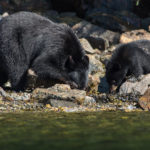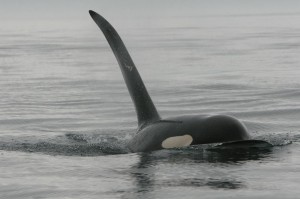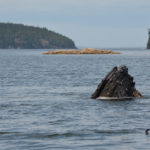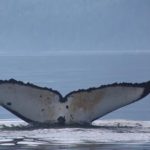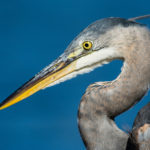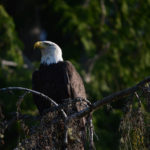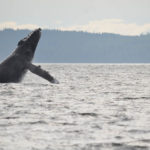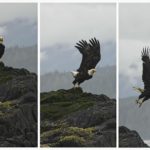In the Knight Inlet area it is rare to see Black Bears feeding on salmon in the river. The reason for this is that the Grizzly Bears are the dominant bears and push the black bears out of these prime areas. The Black Bears tend to be more spread out and when the tide is low we often spot them rolling rocks on the beach looking for shore crab.
Whale Watching
We’re not all about the bears, whales are abundant here too!
Killer whales and humpback whales are often seen during our wildlife tours. There are resident whales and transient whales that can be seen feeding and playing in our waters.
Orca off coastal Vancouver Island
Some photos capture the majesty of the orca. This is a large male coming for a closer look. Often the best approach to viewing marine life in the area between Vancouver Island and the mainland coast is to sit quietly in the boat with engine turned off and allow visitors approach. Lunchtime on a whale watching tour involves drifting and waiting. Photos by
Peter Palstring 5-6
Humpback “Lazy Lunge Feed”
When the humpbacks feed they often lunge out of the water very quickly consuming as many herring as possible. Another lazier technique is to use the current to their advantage. The whales poke their mouth out of the water slowly, open and close it and let the current deliver krill and small baitfish to them. Although not as dramatic it is equally impressive and much easier to see and photograph.
Humpback Whale ID
The Humpback Whales that frequent the waters near the lodge are migratory. Most of the whales in our area head to Hawaii in the winter to mate and have their calves. Biologists are able to identify these whales by taking pictures of the underside of their fluke (tail). These markings are unique and once the whale is mature will not change. They are catalogued and separated according to region and the percentage of white and dark colours. This whale is known as “Guardian.” She is frequently spotted in our waters and has been returning for several years.
For The Birds Pt2
The Great Blue Heron is another bird that we see commonly on out tours. Like the eagle they are opportunistic feeders and are quite proficient at catching small fish. In the ocean they will often sit on kelp or logs and look for unsuspecting fish. In the rivers they hunt for fry (young salmon) and other small fish such as stickleback. Thanks to Felix for the great picture.
For The Birds Pt1
The Bald Eagle is a very prominent bird in our area. It takes them approximately 5 years to get their white head and white tail feathers. Before that they are a drab brown colour and often look larger then their adult counterparts because of their “poofy plumage.” The eagles mate for life and it is very hard to tell male from female, although the female is usually larger. We see them on all our tours both in Johnstone Strait and Knight Inlet.
Humpback Trying to Shake Off Dolphins
This is a picture of the Humpback Whale known as Guardian breeching in Queen Charlotte Strait. What you can’t tell from the picture is that there is a group of Pacific White Sided Dolphins harassing her. Both dolphins and Sea Lions have been know to pester Humpbacks and Resident (fish eating) Orca. Why they do this is still up for debate. She did several breeches and tail slaps in an effort to shake the annoying dolphins.
Bald Eagle Taking Off
Herring Ball Pt2
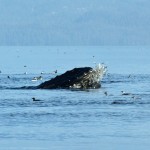 Fish and birds aren’t the only ones who feed on herring balls. Humpbacks often do what is called a lunge feed where they come up from underneath the herring ball with their mouth open and try to consume as many fish as possible. Often when we are out whale watching you will see gulls feeding on a herring ball. When the birds lift off the water it usually means one of two things. Either the fish have dispersed or there is a whale coming up for a snack.
Fish and birds aren’t the only ones who feed on herring balls. Humpbacks often do what is called a lunge feed where they come up from underneath the herring ball with their mouth open and try to consume as many fish as possible. Often when we are out whale watching you will see gulls feeding on a herring ball. When the birds lift off the water it usually means one of two things. Either the fish have dispersed or there is a whale coming up for a snack.
Herring Ball Pt1
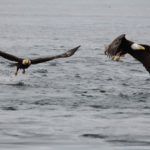 Out in Johnstone Strait it is common to get what are called “herring balls.” Basically these are schools of small baitfish that have been pushed to the surface by fish and diving birds such as aucklets and murrelets. The fish appear to boil on the surface and are easy prey for gulls and bald eagles.
Out in Johnstone Strait it is common to get what are called “herring balls.” Basically these are schools of small baitfish that have been pushed to the surface by fish and diving birds such as aucklets and murrelets. The fish appear to boil on the surface and are easy prey for gulls and bald eagles.
